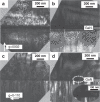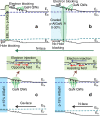Progress on AlGaN-based solar-blind ultraviolet photodetectors and focal plane arrays
- PMID: 33931580
- PMCID: PMC8087770
- DOI: 10.1038/s41377-021-00527-4
Progress on AlGaN-based solar-blind ultraviolet photodetectors and focal plane arrays
Erratum in
-
Author Correction: Progress on AlGaN-based solar-blind ultraviolet photodetectors and focal plane arrays.Light Sci Appl. 2021 Dec 7;10(1):244. doi: 10.1038/s41377-021-00690-8. Light Sci Appl. 2021. PMID: 34876552 Free PMC article. No abstract available.
Abstract
Solar-blind ultraviolet (UV) photodetectors (PDs) have attracted tremendous attention in the environmental, industrial, military, and biological fields. As a representative III-nitride material, AlGaN alloys have broad development prospects in the field of solar-blind detection due to their superior properties, such as tunable wide bandgaps for intrinsic UV detection. In recent decades, a variety of AlGaN-based PDs have been developed to achieve high-precision solar-blind UV detection. As integrated optoelectronic technology advances, AlGaN-based focal plane arrays (FPAs) are manufactured and exhibit outstanding solar-blind imaging capability. Considering the rapid development of AlGaN detection techniques, this paper comprehensively reviews the progress on AlGaN-based solar-blind UV PDs and FPAs. First, the basic physical properties of AlGaN are presented. The epitaxy and p-type doping problems of AlGaN alloys are then discussed. Diverse PDs, including photoconductors and Schottky, metal-semiconductor-metal (MSM), p-i-n, and avalanche photodiodes (APDs), are demonstrated, and the physical mechanisms are analyzed to improve device performance. Additionally, this paper summarizes imaging technologies used with AlGaN FPAs in recent years. Benefiting from the development of AlGaN materials and optoelectronic devices, solar-blind UV detection technology is greeted with significant revolutions. Summarizing recent advances in the processing and properties of AlGaN-based solar-blind UV PDs and FPAs as well as AlGaN growth and doping techniques.
Conflict of interest statement
The authors declare no competing interests.
Figures




















References
-
- Shibata T, et al. Evaluation of the solar-blind effect in ultraviolet ozone lidar with raman lasers. Appl. Opt. 1987;26:2604–2608. - PubMed
-
- McClintock, R. et al. AlxGa1-xN materials and device technology for solar blind ultraviolet photodetector applications. In Proc. of SPIE 4288, Photodetectors: Materials and Devices VI. 219–229 (SPIE, San Jose, 2001).
-
- Safin RG, et al. Solar-blind filter for the ultraviolet region. J. Opt. Technol. 2007;74:208–210.
-
- Kuryatkov V, et al. Solar-blind ultraviolet photodetectors based on superlattices of Aln/Alga(in)N. Appl. Phys. Lett. 2003;82:1323–1325.
-
- Reilly, D. M., Moriarty, D. T. & Maynard, J. A. Unique properties of solar blind ultraviolet communication systems for unattended ground-sensor networks. In Proc. of SPIE 5611, Unmanned/Unattended Sensors and Sensor Networks. 244–254 (SPIE, London, 2004).
Publication types
Grants and funding
LinkOut - more resources
Full Text Sources
Other Literature Sources
Research Materials
Miscellaneous

